Compression bandages and compression garments are key elements in the treatment options for lymphedema therapy. The type of compression garment a patient requires depends on the individual situation and on the activities he or she has to perform in daily living.
Lymphedema is the physical manifestation of swelling from an obstructed or impaired lymph system, such as breast cancer lymphedema after surgery and/or radiation treatment. A lymph system malfunction can lead to a situation where fluid cannot drain from the body’s tissue. This results in a fluid build-up that causes considerable swelling of the affected area.
Lymphedema can have a wide variety of sources and triggers. These can include cancer, cardiac or circulatory conditions, genetics, skin problems as well as infections and being overweight. In rare cases, people can also be born with abnormalities of the lymph system. This is known as primary lymphedema. This type of lymphedema can be caused by hereditary defects. An example of such a defect is Meige Disease, a condition where lymph vessels develop without valves.
What are the Symptoms of Lymphedema?
- Persistent swelling (usually in the arm or leg)
- Pain, aching or discomfort
- Tightness or heaviness in the affected area
- Hardening and redness, and/or thickening of the skin
- Limited range of motion
- Recurrent infections
If you have any of the above symptoms please be sure to consult with your primary care doctor for an evaluation of your concerns.
Unfortunately, once lymphedema is present in most cases it also has a tendency to be progressive. To slow progression it is therefore paramount for patients to have access to effective treatment options, including a certified lymphedema therapist, in order to successfully manage this condition as soon as it is diagnosed.
The first step is to properly diagnose lymphedema. There are numerous illnesses that can cause swelling and many of these other conditions can be present simultaneously with the occurrence of lymphedema. Determining whether the patient has lymphedema may require a series of assessments and tests ordered by the primary care physician or a lymphedema specialist.
Compression Therapy Is Key for Treating Lymphedema
Before we go into more details about the different aspects of compression as part of the treatment strategy for lymphedema, other care measures should also be mentioned briefly here. These would include specialized skin massage therapy to help with lymphatic drainage as well as good skin care and a proper exercise routine. All of these are important components working in conjunction to round out an effective treatment program for lymphedema.
Compression Treatment for Lymphedema
If the arms and/or legs are significantly enlarged the swelling can be reduced utilizing compression. To accomplish this, the first step often involves the use of specialized compression wrapping bandages, which are designed to reduce the swelling to a point where the patient can wear other medical compression garments.
Lymphedema patients should also wear a suitable and well-fitted compression garment while performing exercises that utilize the affected body part.
Lymphedema Garments
This type of medical compression wear includes all elastic garments such as snug-fitting sleeves or stockings or body suits that are used to reduce the swelling caused by a buildup of fluid in the tissue. They can also be used to improve blood circulation.
Some hospitalized and homebound patients with more severe cases of primary or secondary lymphedema require treatment with pneumatic compression devices. Such a pneumatic pump generates a “milking” effect, which promotes lymphatic fluid flowing in the desired (distal to proximal) direction.
What Are the Benefits of Lymphedema Compression Garments?
- They can reduce/prevent fluid build-up in the area where they are applied
- Compression garments can assist the natural muscle pump function to move blood and fluid efficiently
- Compression can help force fluid away from one area to an area where it can be drained more effectively by the lymph system
Compression garments are designed to apply a controlled amount of pressure on the swollen arm or leg to help drain the fluid from the tissue and prevent a buildup. Some patients may require custom-made garments for a correct fit if their arms or legs are too large to fit a standard size compression stocking or arm sleeve.
Wearing compression stockings or sleeves during exercise can also help prevent more swelling in the affected leg or arm. In addition, it is also important to know that compression garments should always be worn on flights because lymphedema is known to become worse at high altitudes.
Types of Lymphedema Compression Garments and Devices
Compression Bandages
If the patient’s arms or legs are too swollen to accommodate a compression stocking, special multi-layer bandages must be applied. The goal is to reduce the swelling to a level where it is possible to fit the individual with a compression sleeve or stocking.
Bandages must be applied daily by a lymphedema specialist or a specially trained caregiver. In cases of severe edema, it may take several weeks of bandaging before the patient’s leg or arm can fit into a stocking or sleeve.
The reduction of lymphedema swelling with the help of bandages during the treatment course is known as decongestive therapy. Lymph drainage massage, proper skin care, and exercise are often combined with the bandaging to reduce the swelling.
Leg Compression Bandages and Wraps
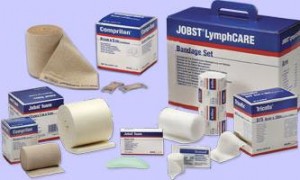
Compression bandaging is generally used before the patient can wear a compression garment.
Bandages are designed to help reducing swelling and stabilize the size of an arm or leg before the patient can be fitted with a compression wrap or stocking.
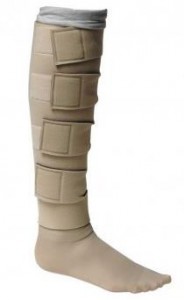
Example of a compression wrap for lymphedema in the lower legs.
The compression level for the fastening straps can be adjusted from 20 to 50+ mmHg simply by tightening the Velcro straps more or less.
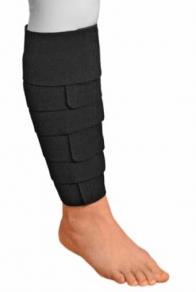
This is another calf compression wrap alternative by Solaris brand.
According to the manufacturer, the unique design with a spine that holds the shape and color-coded strapping makes donning and doffing of this garment easy.
Similar wraps are also available for the thigh, knee, and foot for targeted compression.
Compression Arm Sleeves and Wraps
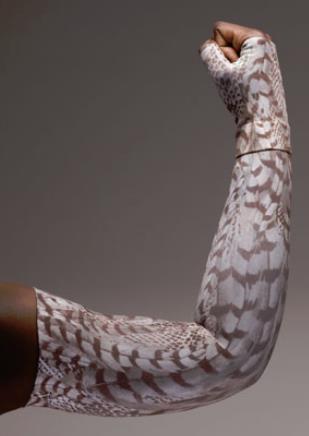
You can even be stylish when you have to wear a compression arm sleeve for upper extremity lymphedema.
To keep you comfortably cool and dry the garment shown in this example is moisture wicking and a silicone and latex free top band ensure that your compression sleeve stays in place.
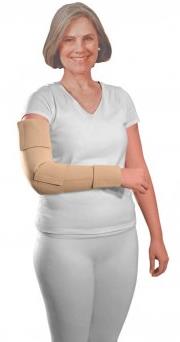
This compression arm wrap is specially designed with a liner that makes one-handed easy on, easy off application possible.
Compression Gauntlets, Gloves, and Hand Wraps

Lymphedema sleeves and gauntlets are effective devices for a number of lymphedema conditions including those experienced subsequent to surgery, radiation treatments or trauma.
They can also be helpful with burn therapy, tennis elbow or after a stroke and when a cast has been removed.
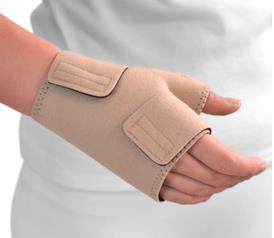
If the patient requires adjustable compression for the hand, this gauntlet with adjustable straps easily provides the compression range that is needed for variations in size during decompression therapy.
Compression Stockings
Once the level of swelling from lymphedema in the legs or arms is controlled to a point where the limb has regained a more normal shape, the patient can be fitted with compression stockings and sleeves for the arms. Compression stockings or sleeves will be prescribed by the primary care physician or the lymphedema specialist.
In most cases, a highly experienced and trained fitter will carefully measure the arm or leg for proper sizing of the compression garment. For additional information on measuring and fitting please also read our related post
The Importance of Correct Measurements and Sizing
Should Compression Garments Ever Not Be Applied?
There are in fact situations where compression garments should not be used. This is especially true for cases where the arm or leg is extremely swollen and of irregular shape. Other reasons would include limbs with sensitive or damaged skin that are leaking fluid. In such cases, the primary focus would first be to restore a more normal shape and size of the limb and to resolve any leaking sores or ulcers of the skin.
Lymphedema garments play a vital role in treating and managing swelling caused by malfunctioning or blocked areas of the lymphatic system. With their comfortable application, they allow many lymphedema patients to resume their daily living with significantly less discomfort and disruption and they can even be fashionable in appearance.
If you liked this post please let us know by clicking the Facebook like button below. We also appreciate any comments and personal experiences you have to contribute.
Thanks for this very helpful article. I learned the name of my condition just this afternoon, but have been living with it for the past two months. Now I’m on the hunt for compression leggings.
Just one question — would the compression leggings found in athletic wear stores be of help, too? Like the ones worn by basketball players?
You may need stockings or leggings with graduated compression. However, active wear compression leggings in most cases do not provide graduated compression, which is the type of compression that is the strongest at the ankles and then gradually decreases as you go up the leg, being the lowest at the upper thigh area.
You should check with your medical care provider for his or her recommendations. Good luck and best wishes for improvement in your condition!